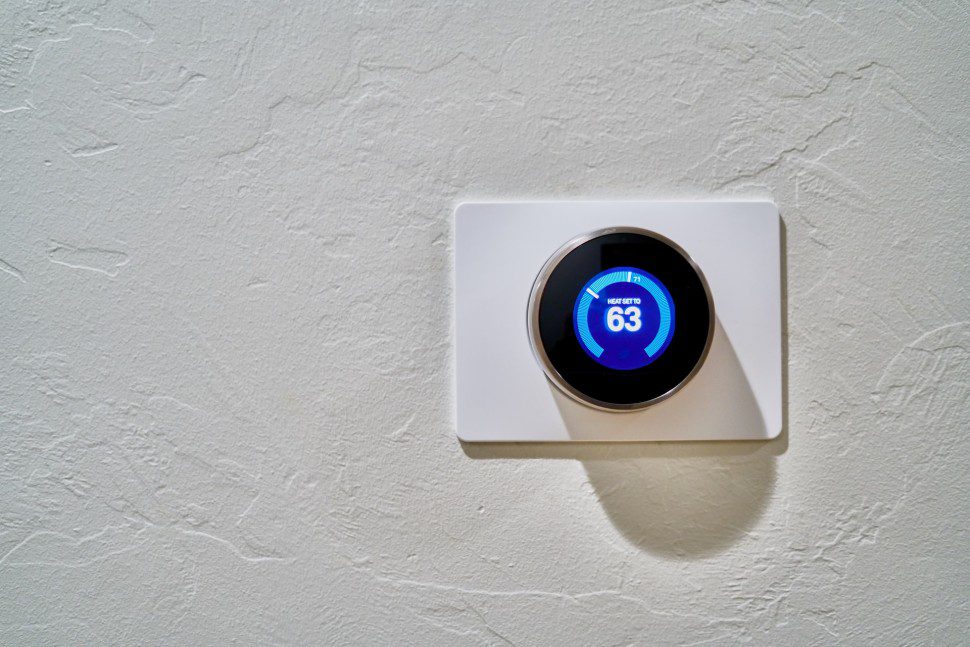Nothing is more critical than the thermostat when maintaining a comfortable temperature in your homes. You won’t be able to enjoy the benefits of the most advanced heat pump system to the fullest without the right thermostat.
If you have a heat pump or any other heating system, you will need to get a compatible thermostat explicitly made for it. There are two types of thermostats available today: on-off and programmable. On-off thermostats are basic models that switch the heater on when it falls below a certain temperature threshold and vice versa. Programmable thermostats are more advanced devices that allow users to set different temperatures at different times of the day.
In this article, we will focus on the review of thermostats. Let’s take a look at our top picks and some of each’s pros and cons!
Heat Pump Function
A heat pump is a device that transfers thermal energy from a hot location to a cold location, using a minimal amount of external power. Heat pumps move thermal energy in the opposite direction of spontaneous heat flow by taking heat away from a cold environment and transferring it to a hot location.
The function of a heat pump is to move thermal energy from a lower temperature to a higher temperature. The heat pump must first absorb the heat from the lower temperature source and then release it to the higher temperature sink. It uses a small amount of external power to accomplish this work.
The heat pump is an efficient way to transfer heat energy from one area to another. It is so efficient that it can reverse the direction of heat flow and cool. When used for cooling, the heat pump transfers heat from the inside of a building to the outside. It is the same process used for heating but in reverse.
Thermostat for Heat Pumps
A thermostat for heat pumps is a device that controls the operation of the pump, regulating the temperature of the air or water in the system. The heat pump is usually located near and may integrate into the unit, or it may be a separate device. You may control the thermostat manually, or a controller may automatically regulate the heat pump’s operation.
A thermostat can adjust the temperature in a room by turning the heating or cooling system on and off intermittently (by sensing the current room temperature with the help of sensor-equipped thermostats). The heat pump thermostat turns the heat pump on and off to maintain the preferred room temperature constantly. It always saves energy usage and money in the long term by regulating the system effectively. A good thermostat will save you money and energy if you choose it correctly.
When buying a heat pump thermostat, the most important thing to remember is that not all thermostats are compatible with heat pumps. You must choose a thermostat that is compatible with your heat pump.
Choosing the Best Heat Pump Thermostat
If you are looking for a new heat pump thermostat, there are a few things you should keep in mind. There are many different brands to choose from, so it is essential to research the right one for you.
Compatibility
When selecting a thermostat, you must pay careful attention to ensure that the system is compatible with your heat pump. Some thermostat models do not support HVAC systems that use heat pumps. You must scrutinize the specifications before purchasing a thermostat.
Budget-Friendly
Choosing the right thermostat is dependent on what you want and how much you’re willing to spend. If you’ve already narrowed down your choices to a couple of heat pump thermostats, you’ll soon be choosing the characteristics you want and your budget. A smart heat pump thermostat (such as Nest, Ecobee, Honeywell Lyric, and others) includes high-end self-learning, automatic programming, wireless connectivity, mobile app control, geo-fencing, voice control, etc.
However, those features come at a cost. If budget is an issue, you can opt for an ordinary thermostat for heat pumps, which will do the job and maintain efficiency.
Emergency Heat
You may build an emergency heating system into a heat pump, and if so, you must select a thermostat that supports the same. Specific thermostat models support heat pumps, but they do not support aux/emergency heating systems. Therefore, if your heat pump has an aux heat feature, select a thermostat that supports heat pumps with auxiliary heating.
Heat pumps operate well with moderate temperatures but might take longer than usual to warm your rooms if the weather goes extreme, such as during a freezing winter. Some heat pumps are equipped with emergency heating to deal with such situations. Auxiliary heating quickly accomplishes the heating. It is not energy efficient and increases energy consumption. However, it is a quick and effective way to heat a room.
Wiring
Heat pump thermostats require unique wiring, so you must verify whether yours does before purchasing them. You may verify whether your desired thermostat supports heat pump wiring by consulting the manufacturer’s specs or checking the model number online.
Smart Thermostat for Heat Pumps
A smart thermostat for heat pumps is a device that helps to regulate the temperature in your home by using sensors to detect when the heat pump is on and off. It then automatically adjusts the temperature accordingly. It can help save energy and money by ensuring that your heat pump is only used when necessary. The following are some of the best smart thermostats for heat pumps:
Sensi Smart Thermostat for Heat Pumps
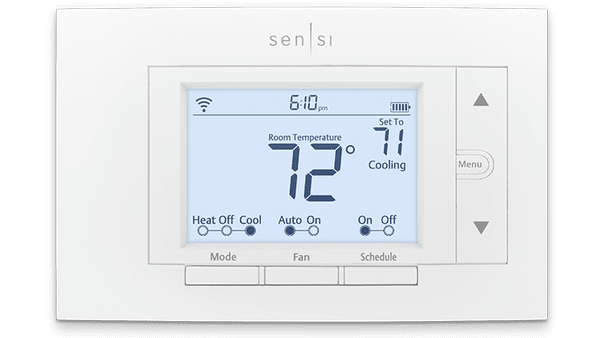
Emerson thermostats manufacture this thermostat, and it works with your existing wires. It has a simple and fast DIY installation procedure because it does not require a common wire (c-wire). Since it is compatible with most heating and cooling systems, it does not require a c-wire.
Ecobee 4 Heat Pump Smart Thermostat
[amazon fields=”B07NQT85FC” value=”thumb” image_size=”large”]
The Canadian firm Ecobee makes smart thermostats, especially for North America, and they’re good at it. The Ecobee 4 is a full-featured smart thermostat that includes heat pumps (4H/2C – 4 stages of heating and 2 stages of cooling) and heat pumps with auxiliary/emergency heating (2 stages of aux heating). Using accessories (common with heat pumps) like humidifiers, dehumidifiers, ventilators, ERVs, and HRVs, Ecobee 4 works with a wide range of heat pumps.
Nest E’s budget-friendly smart heat pump thermostat is similar to the Ecobee 4, but it has a shorter build and feature set. The model Ecobee 3 Lite, compatible with heat pumps (Y1 and Y2) and heat pumps with aux heating (W1 and W2), is available at a reduced price.
Nest 3rd Generation Smart Thermostat
[amazon fields=”B0131RG6VK” value=”thumb” image_size=”large”]
This thermometer’s 3rd generation device can control heat pumps with auxiliary/emergency heating. It supports heat pumps with auxiliary/emergency heating that operates on heat pump systems and heat pumps. The Nest 3rd Gen & Ecobee 4 thermostats are ideal for heat pump-based systems. They both support multi-stage heat pumps, and they both support up to two heating stages for auxiliary heating. They are both WiFi-enabled and work well with heat pump systems.
Nest 3rd generation thermostats turn on auxiliary heating when required (only when the outside temperature falls below the lockout temperature). Nest automatically activates a heat pump balance and determines the lockout temperature for auxiliary heating.
If you’re unfamiliar with Nest’s self-programming thermostats, it automatically configures itself based on your daily routines. Nest thermostats usually take 7 to 10 days to learn your way after installation and self-program themselves for optimal energy saving. The Nest E is a budget-friendly heat pump thermostat that works with heat pumps and aux/emergency heating. Our post described the differences between Nest E and Nest 3rd Gen. You can use this thermostat as a WiFi heat pump because it is WiFi-enabled.
If you look at the back of the thermostat, you will see O/B and AUX/E (O/B and AUX/E) labels. The thermostat is compatible with heat pumps (O/B) and aux/emergency heat pumps (AUX/E). It’s a straightforward way to verify if a thermostat model is compatible with heat pumps by examining its wiring labels. You can tell if a thermostat is compatible with heat pumps by looking for two identifiers: O/B for heat pump compatibility and AUX/E for auxiliary heating compatibility.
Honeywell (RTH9585WF) Heat Pump Smart Thermostat
[amazon fields=”B09RV3F73J” value=”thumb” image_size=”large”]
The Honeywell RTH9585WF WiFi Heat Pump Thermostat is one of the most popular WiFi/Wireless thermostats with smart features like internet-based long-distance control via smartphone apps, WiFi/Wireless control, and touch screens. Its conventional box-shaped design is a big drawback. Nest and Ecobee models offer the same features, including internet control via smartphone apps, Alexa voice control, etc.
Nest and Ecobee follow a sleek, round-shaped, minimal design pattern for all of their models, which is trendy and works well with contemporary interiors. This thermostat manages both heat pumps and heat pumps with auxiliary heating. It connects to either one or two phases of heat. Using a Honeywell thermostat, you can adjust the cooling changeover valve mode (see installation manual for more details). Emergency heat is known as ‘backup heat.’
To activate the backup heat function on a Honeywell thermostat, you must connect the W2-Aux/E wire to your heat pump’s Aux/E wire. If your heat pump has two Aux wires, connect them to the W2-Aux/E terminal (RTH9580WF). Ecobee and Nest smart thermostats cannot be self-learned on this thermostat.
This model includes several standard features: voice control (compatible with Amazon Alexa), WiFi control, remote management via mobile apps (iOS and Android versions), touchscreen, and holiday schedule. Smart energy savings are among the many advantages of this thermostat.
This Honeywell thermostat has a bigger screen than the Ecobee or Nest models, both minimalist. Those with poor eyesight or other visual impairments will appreciate the large screens and simple legibility while setting up or adjusting the schedule. You may also choose a color scheme that matches your decor. You may set the touch screen to any color of your preference.
Best WiFi Heat Pump Thermostat
If you are looking for a new WiFi thermostat for your heat pump, you may want to consider the following list:
Honeywell RET97E5D1005/U Wi-Fi Programmable Thermostat
[amazon fields=”B00EP6C8I2″ value=”thumb” image_size=”large”]
The Honeywell Wi-Fi smart thermostat gives you remote temperature and time control, managing multiple thermostats, pre-heating and cooling, and energy-efficient scheduling. It does not work with electric baseboard heat (120-240V) on heat pumps.
Bosch Connected Control Wi-Fi Thermostat (Alexa-Enabled)
[amazon fields=”B073XHD8BB” value=”thumb” image_size=”large”]
This Wi-Fi thermostat from Bosch allows simple scheduling to make your home warm and cozy during cold days. Like all the Wi-Fi thermostats reviewed above, you can adjust its temperature and timing remotely (through a mobile app). Some of its other vital functions include a five-inch color touch-screen display, Alexa-enabled (voice-activated), so you can control it from your home, and a mobile app that allows you to manage schedules for up to four thermostats.
You may control the BCC100 using an internally powered humidifier or dehumidifier and most 24-volt HVAC systems.
Honeywell TH6320WF1005
[amazon fields=”B00B0W070K” value=”thumb” image_size=”large”]
Honeywell’s Wi-Fi FocusPRO 6000 thermostat has a 7-day programmable memory and a user-friendly interface. It comes with a large, backlit display and push buttons that make it easy to control.
It has the following characteristics in addition to its browser smartphone app interface: (1) It helps you install the thermostat by guiding you through the process. (2) You can set the temperature settings without a Wi-Fi connection using the conventional programmable thermostat. It sends you updates through email when asked to do so. (3) It is compatible with 3Heat/2 Cool heat pumps and 2Heat/2Cool conventional systems and sends you temperature settings through iOS or Android devices.
Honeywell TH9320WF5003 WiFi 9000
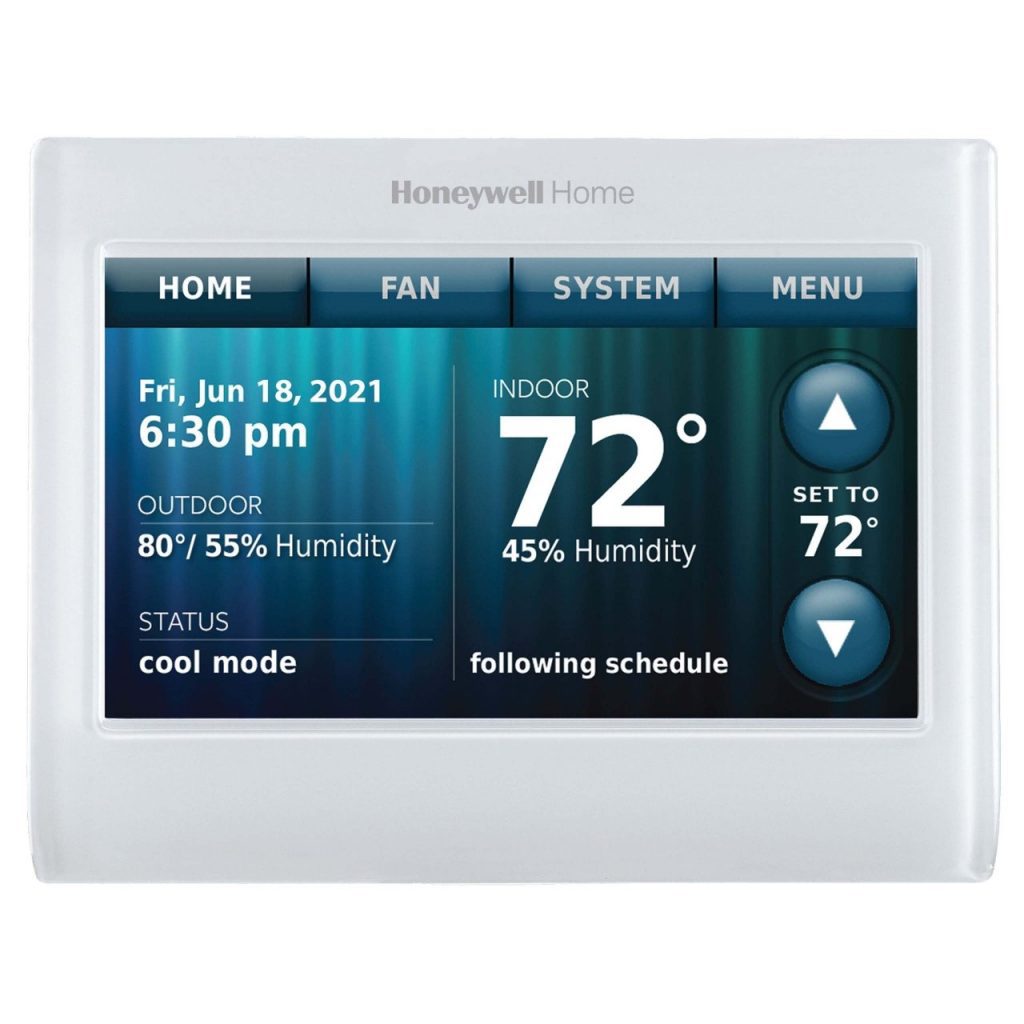
You can save energy by reducing your bills with this Honeywell product. The 7-day programmable memory on this thermostat can help you save energy. You may also personalize its touchscreen color to match your room’s decor. Some of its other features include: connecting the thermostat to your Wi-Fi network at home and remotely programming its schedule via the app or browser on your device.
Alexa voice recognition technology enables you to control the temperature with your voice. If you do not wish to program its schedule, you may use this thermostat as a nonprogrammable model. The 7-day programming is simple and includes an energy savings mode feature.
Touch Screen Heat Pump Thermostats with WiFi
Emerson Sensi Touch Wi-Fi Thermostat
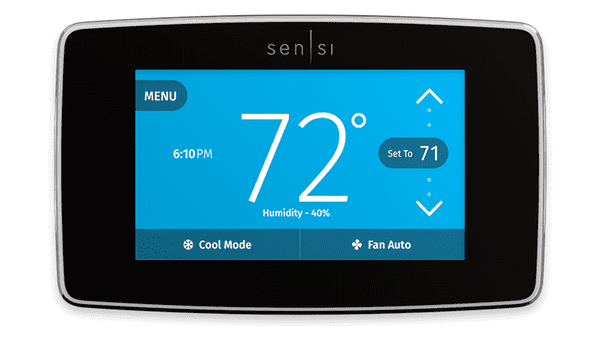
Sensi’s thermostat has an HD touch screen that displays the room temperature and has intuitive menus and a backlight. It includes a detailed instructional manual for a simple DIY setup. You can remotely control this thermostat’s control functions with the Sensi app. It alerts you when temperature and humidity levels become too extreme in your home. You can use the geofencing feature to locate the temperature.
You can reduce the amount of energy in your heating, cooling, and heat pump systems using a 7-day program with four-hour periods each day. Large, legible backlit display. Installation wizard for easy setup. Compatible with gas, electric, and heat pump systems.
Bosch Connected Control Wi-Fi Thermostat (Alexa-Enabled)
[amazon fields=”B073XHD8BB” value=”thumb” image_size=”large”]
You can use this Wi-Fi thermostat from Bosch to create a comfortable and cozy atmosphere in your home on cold days. You may control the temperature and timing settings using your mobile phone or other Wi-Fi thermostats. Some of its essential characteristics are: The BCC100 mobile app allows you to manage up to four thermostats using your voice while at home. A 5-inch color touch-screen display.
You may use the BCC100 mobile app to manage up to four thermostats. It works with Heat Pump (4 Heat, 2 Cool) or Conventional (2 Heat, 2 Cool) systems, 1-wire internally powered humidifiers and dehumidifiers, and most 24 VAC HVAC systems.
Best Thermostat for Heat Pump with Auxiliary Heat
Orbit 2-Pack 83521 Clear Comfort Programmable Thermostat
[amazon fields=”B01D16HAFW” value=”thumb” image_size=”large”]
There are various features included with this thermostat. Here’s what you can get out of it. You’ll be able to learn whether this thermostat is compatible with your requirements after you know about its functionality. The unique abilities start with a 7-day program. This thermostat allows you to set the next seven days’ temperatures as per your preference, providing four independently adjustable programming periods. It utilizes a warm backlight to create a realistic view from any room corner.
The thermostat begins early and turns on quickly to ensure that we achieve the desired temperature within the specified timeframe. It maintains a comfortable environment in the home by regulating the temperature. It will never provide a false temperature reading, whether in Fahrenheit or degrees Celsius.
Emerson Sensi Touch Wi-Fi Smart Thermostat
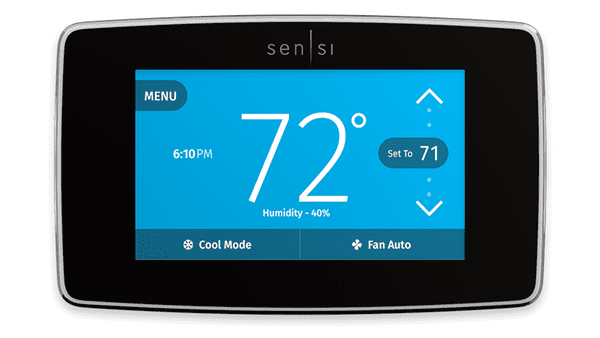
The Sensi Touch Wi-Fi Smart Thermostat received Best Value Thermostat awards in 2017, 2018, and 2019 from USA Today. This thermostat has gained popularity over time because of its affordable price. It is now available on Amazon with over 1,500 positive reviews and a 4.5-stars rating out of 5, and it still is. This thermostat comes with voice compatibility with Amazon Alexa, Google Assistant, Apple Home Kit, Samsung Smart Things, and Wink smart home platforms and saves your energy and money.
DIY installation minimizes the hassle and ensures accuracy. You don’t have to hire a professional to install it, and you can install it in 30 minutes. This thermostat will increase confidence since you do not need a C-wire (common wire) for all system types. Visit sensi.emerson.com/compatibility to ensure that the Sensi thermostat will work in your home for all system types.
Honeywell TH9320WF5003
[amazon fields=”B00WDXY530″ value=”thumb” image_size=”large”]
The Honeywell TH9320WF5003 Wi-Fi Touch Screen Programmable Thermostat is a great option. Thanks to this excellent wifi thermostat for a heat pump, controlling your home’s inner temperature will never be so easy. Thanks to the thermostat’s integrated sensors, it’s simple to hook up and operate. You’ll see noticeable results immediately after hooking up this thermostat to your HVAC system.
Total Connect Comfortable is available for download and installation on your tablet or smartphone so that you may connect wirelessly. It connects to your Wi-Fi connection and allows you to program the thermostat. Additionally, Honeywell provides impressive customer service and a five-year warranty on all its customers items.
Emerson 1F72-151
[amazon fields=”B01LY4YS1L” value=”thumb” image_size=”large”]
This Emerson 1F72-151 5-2 is primarily intended for heat pumps. It controls heating and cooling and provides backup heat strips if the compressor is damaged. This gadget is suitable for those installations with a single-phase compressor with emergency and auxiliary heating strips. It is a beautiful device that performs as promised. It will save you cash and function as you desire if you install it correctly.
To install this Wi-Fi thermostat, you must be simple. It will save you money and operate as you like if you program it with the five-weekday and two-weekend programs. One program controls warmth, while the other controls coolness.
Honeywell Inc. TH6220WF2006
[amazon fields=”B071GRB33D” value=”thumb” image_size=”large”]
The Honeywell Inc. TH6220WF2006/U Lyric T6 Pro Wi-Fi Programmable Thermostat is not just the flagship of the Lyric series, but it also includes the entire Honeywell series line-up. It requires some effort to set up this product, but you can do so by following the directions that come with it. It’s simple to install. With just a few clicks, you can control the temperature and fan speed of your air conditioners and furnace. This app will allow you to adjust the temperature of your home.
You can also control and monitor the temperature and speed of the fan with products like ecoBee4 and Nest. These are examples of third-generation thermostats that are more expensive but will satisfy all your requirements. You can program the thermostat to switch to Away mode when your phone leaves a virtual fence surrounding your home using geofencing technology. By having less of it, you’ll lower your electricity bill.
Best Digital Non-Programmable Heat Pump Thermostats
Honeywell RTH3100C1002/E1
[amazon fields=”B000VL440U” value=”thumb” image_size=”large”]
This non-programmable thermostat has excellent precision and is mercury-free. You can adjust the thermostat to meet your needs, whether you want to maintain a specific room temperature or not. The display is easy to read, with a green backlit digital screen. With a non-programmable thermostat, you set the temperature and let the thermostat handle the rest. It comes with a push-button interface that is simple to use.
This thermostat works well with Multistage Heat Pump Systems (Heats pumps with and without an auxiliary heating source).
Honeywell TH5110D1006
[amazon fields=”B000GGPMO2″ value=”thumb” image_size=”large”]
This thermostat is not programmable and has a 1.5″ display and push-button interface. It is battery-powered with a replacement door. This device electronically controls 24 V AC conventional and heat pump systems or 750 mV heating systems. It is incompatible with 1 heat/1 cool traditional systems or heat pumps requiring auxiliary equipment.
Honeywell RTH5100B 1025
[amazon fields=”B002RL9BIM” value=”thumb” image_size=”large”]
It’s incredibly user-friendly thanks to its soft key push-button interface and green backlit display. This non-programmable digital thermostat from Honeywell minimizes temperature swings to help you live in a comfortable and welcoming environment. You can easily adjust the temperature with the up/down buttons. Even after a power failure, the thermostat maintains the set temperature. It is suitable for all central heating and cooling systems, including heat pumps without an auxiliary heat source.
Benefits of Using the Thermostat for Heat Pump
Comfortable scheduling: There are 3 types of programmable thermostats on the market. You can choose from among them according to your needs. If you maintain a different schedule every day, the 7-day thermostat is a good choice. The 5-2 thermostat is appropriate for those who support different settings for five weekdays and two weekends. The 5-1-1 thermostat is the last option for those who have different schedules for five workdays and two weekends.
Saves energy bills: Using a thermostat correctly can help you save money on your electrical bills. You may use a thermostat’s programmable function to control the temperature, turn on and off your household appliances, and save money on your electricity bills. For example, you may turn off your air conditioner without being home. You can turn it off simply by pressing a button on the thermostat. They will automatically adjust your home temperature when you are asleep.
Precise, controlled temperature: According to the Air Conditioning Contracts of America, an analog thermostat will be less accurate than a programmable variety. According to the study, a thermostat with an analog setup would be off by up to 5 degrees Celsius. On the other hand, a programmable thermostat would be off by 1 degree Celsius. They’re more precise than analog thermostats. You’re certainly consuming more energy than you should, so you’re receiving extra electricity bills.
You don’t realize that you don’t know the proper temperature for your residence. You can’t disagree with me, can you? It won’t take much time to make you some money.
Enhance the efficiency of your home: Your house will be more efficient throughout the entire year if you use a thermostat. Your systems will last longer because you will effectively use them. You will also be able to relax and be comfortable due to today’s advanced thermostats.
Controlling the motion, light sensors, and humidity: An occupancy-based thermostat will adjust the temperature based on the amount of light or movement inside a home. Dehumidifiers and humidifier thermostats automatically keep humidity levels within a comfortable range, whether it is summer or winter, by adjusting the temperature based on the amount of light or motion within a room.
The humidity level must remain between 30% and 50%. You may experience allergies and asthma if the humidity level is outside this range. You may experience damage to the structure of your house, including the development of mildew and rot.
Conclusion
When choosing a thermostat, compatibility with your current HVAC system is essential. Some thermostats can be purchased in-store, while others are only available online. For the most comprehensive selection of models and pricing, it’s best to visit an online retailer. If you’re not sure of what type of system you have, take a picture of your existing thermostat and do a quick search for it online. An introductory service call from your HVAC repair company should determine full compatibility. You can locate all the information you need by consulting your owner’s manual.
FAQ
Why do I need a thermostat?
A thermostat is a device that regulates the temperature of space. Thermostats can control the temperature of a room, a building, or an entire home. There are many different types of thermostats, and each has its advantages and disadvantages.
What is the working process of a thermostat?
A thermostat is a device that regulates heating and cooling systems, ensuring the temperature in a room or building stays at a comfortable level. The thermostat monitors the air temperature and turns the system on or off to maintain the desired temperature.
Why does a thermostat show poor performance or stop working?
Here are a few reasons why a thermostat might show poor performance or stop working altogether. The most common sense is that the batteries need to be replaced. If the batteries are low or dead, the thermostat won’t be able to read the temperature and make the necessary adjustments accurately. Another possibility is that the thermostat is dirty or dusty, interfering with its ability to read the temperature correctly. Finally, the thermostat might simply be old and in need of replacement.
